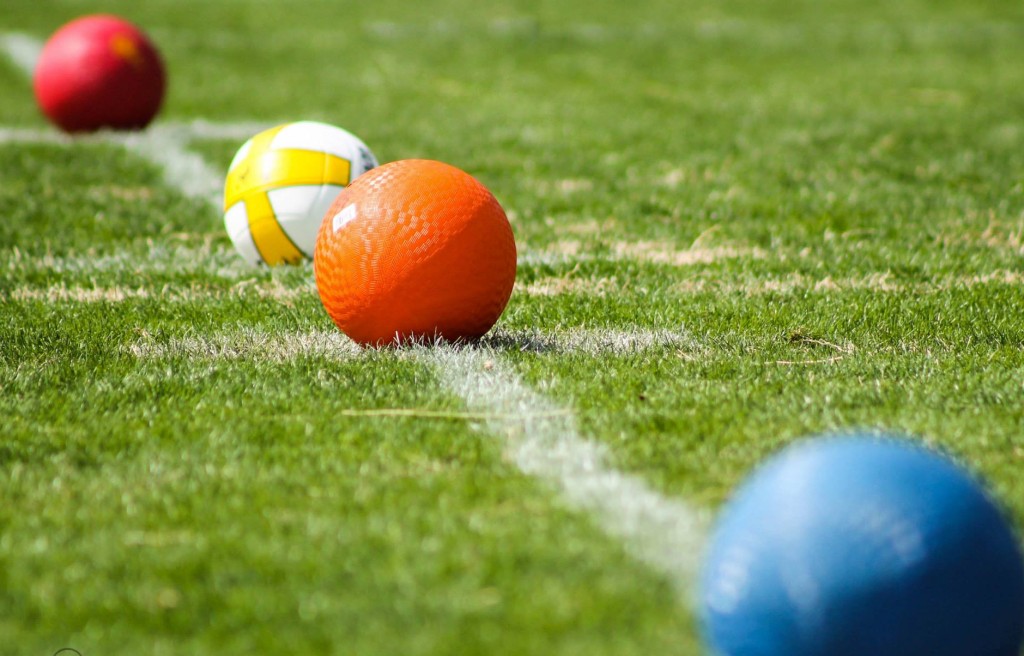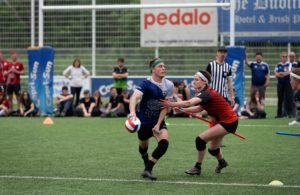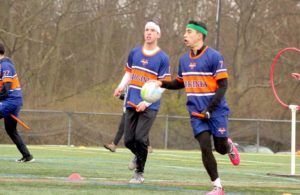- Rule, Britannia, no more?
- Unpopular Opinions: US Quadball Cup 2023
- Proven Contenders: University of Virginia
- Proven Contenders: Rutgers University
- Proven Contenders: University of Michigan
- Proven Contenders: Creighton University
- Different Perspectives: A Look Inside USA Ultimate
- Antwerp QC, Much of Belgian Core, Leaves Competitive Quidditch
Speaking Out: Beater Injury Prevention
- By Ethan Sturm
- Updated: February 27, 2015

Credit: Nicole Harrig
This has been one of the most difficult articles I have ever written about quidditch. Sports injuries are simply not a pretty topic. Watching gut-wrenching twists and tears while listening to ear-piercing screeches on repeat is difficult enough as a neutral onlooker. It is damn near impossible when it is people you know and care about. Almost every night this week, I have laid in bed, my macabre research playing over and over again in my head, unable to sleep.
But having made it through, I have come to one very clear conclusion, one that I am willing to argue to the death. It is a conclusion that, if not dealt with, could have a troubling effect on the future of our sport.
We are not doing enough to protect our female beaters.
Now, before I start, I am putting in a few disclaimers, because at this point in our community, if I don’t, we will all end up spending hundreds of comments discussing the fringe takeaways of the article instead of the actual point.
First off, there is a reason that I am singling out female beaters. In the upper echelons of the sport, where this problem mainly resides, the average male beater has a significant size advantage over the average female beater. This includes the Mollie Lensings of the world, who are probably more fit than just about anyone they go against but are still much smaller. There is a reason combat sports have weight classes. Female beaters are also the ones generally asked to play the back position in a vertical beater set, which, as I will explain later, makes a player more susceptible. And finally, the real reason is that the current injury epidemic plaguing beaters is heavily tilted toward female players. For every David Gilbert injury at World Cup VII, there are five or six cases involving prominent female beaters. And, very likely, this is because, strategically, they are being targeted.
“The go-to strategy for the majority of competitive teams when they lose control is to go lay out the opposing team’s girl beater,” said Baylor University’s Brittany Ripperger. “It cracks me up that they target us and not the guys…but I guess we are the easier target since most guys have a good 40 pounds more on them than most beater girls. So with that said, almost every single play they are attempting to take out the girl beater.”
My second disclaimer is that this is not a witch hunt. Because this article focuses on prominent injuries in major games and that is where most of the film we have comes from, certain players are likely to show up as the instigators more often just by being the ones playing in these games. And at times, these players do clearly illegal things in the process of injuring their opposition. But, I am not looking to imply intent in this article. I will not be claiming that these plays were malicious. Illegal things happen often, these are just the ones with the worst outcomes.
Alright, with that out of the way, let’s dive right in.
Beater is an incredibly unique position in sports. They use their own balls, and they basically can’t score. They are also the only position in sports that can be tackled while playing defense. The idea of a point defender getting blindsided by a full-speed, full-force tackle to take them out of the play sounds completely ridiculous. After all, that defender clearly can’t be prepared to take that hit safely. Then you realize that is the reality beaters deal with every single play.
I think the best play to exemplify this is one that is gaining popularity among beaters. A slight variant on the 1.5 play, a beater attacks a lone defensive beater with a bludger in hand. At the last second, they toss away their bludger to go in for a hit. Here is an example of Texas State University’s Ryan Peavler executing the play against Lone Star Quidditch Club’s Savannah Allison.
(Time Stamp – 15:58)
Now let us put ourselves in Allison’s shoes for a second. As both Peavler and the quaffle play approach her, she is stuck in two minds: She needs to be prepared for Peavler to throw at any minute, positioning her body in a way to either block or dodge the close-range throw and she needs to keep herself positioned between the quaffle play and the hoops. Then, in about a half second, she has to try to make a sudden adjustment to safely take a full-speed hit that wasn’t even an option a second earlier. It should come as little surprise that she ends the play rolling over on her neck and exiting the game.
Compare this to a chaser. First of all, a chaser never even has to have a tackle in the back of their minds when they don’t have the ball. When they do have it, they are the center of the play and are free to move horizontally as much as they want in order to avoid a hit. And, when a chaser is at their most vulnerable in possession of the ball–going up to try to make a catch–a hit on them isn’t just a penalty, it is a red card.
More standard 1.5 bludger plays can be just as dangerous because beaters, particularly back beaters in a vertical setup, need to hold their positions. University of Miami and Team USA beater Shannon Moorhead lost much of her spring season last year to a broken collarbone when she got caught flat-footed on a charge from Florida’s Finest beater Sean Pagoada in such a situation.
“Her beater partner was in the box and she just took the hit straight up,” Pagoada said of the play. “It was not excessive but she didn’t really try to avoid it.”
Beaters can also be forced to follow quaffle play in a way that takes an attacking beater out of their central vision and places them in their peripherals or, even worse, their blind side. This is what happened to Tribe Quidditch’s Mandi Amigh at Lone Star Cup against University of Texas. Late in a play, the quaffle ends up behind the hoops. With her focus in that direction, she ends up with no ability to prepare for the hit from the Longhorns’ Michael Duquette.
(Time Stamp – 14:00)
Of course, this play dips into the other majorly problematic pillar of this rash of injuries: proper refereeing of them. While the hit in its entirety is difficult to see in the film, it is hard to argue that it is not excessive force or at least dangerous play, seeing as Amigh flies about five feet in the air. But while Amigh was transported to the hospital, Duquette stayed on the field. The only card in the play was given to Tribe for, assumedly, unsportsmanlike conduct in response. Also missed on the play was the Tribe male beater lowering his shoulder on Duquette to prevent him from initially hitting Amigh.
While major hits in the middle of the field, such as the above, rarely go unnoticed, it is very common for illegal play to go unseen and uncalled while chasing down balls on the periphery of the pitch. Texas’ Christian Dowdle ended up with a knee injury that kept her out of the Southwest Regional Championship while chasing down a loose ball alongside Peavler at Lone Star Cup. The two were engaging in standard, legal grappling before a quick hip check from Peavler sent her falling to the side onto her knee.
(Time Stamp – 6:18)
It is clear that the play was illegal, but some of the most talented referees in the sport agreed that it would be a hard foul to see on first take. But by not calling it in borderline situations like this, players are more likely to do the same again in the future.
Madeleine Wojdak of the Lost Boys was also the victim of an uncalled, loose-ball foul, which happened far enough out of the play in her team’s game against Arizona State University at the West Regional Championship that it was not even caught on film.
“The [Arizona State] female beater grabbed the ball and attempted a beat but missed,” said Wojdak, who is currently on crutches and awaiting the results of an MRI. “I raced her to the ball, and when I got there, she was still a couple of steps behind me so I decided to kick it. All of my weight was on my left leg, and as I was mid-kick, she dove for the ball from my back-left side, turtling the ball and making contact with my left calf.”
In perhaps the biggest irony of all, it was Wojdak who ended up receiving a card on the play for kicking Vicky Sanford, the Arizona State beater.
“The referees had to ask me multiple times what happened as I was screaming in pain and waiting for an EMT, because they didn’t really see it,” Wojdak continued. “I believe they gave me the card based on my description of the events rather than based on what they saw. In the video, you can see that there wasn’t a bludger referee anywhere near me.”
But nothing exemplifies the problems at the heart of this issue–the dangerous plays and the missed opportunities for referee assistance–as well as what happened to Baylor University’s Brittany Ripperger in the Southwest Regional semifinals. Halfway through the game, Ripperger found herself chasing down a bludger behind her own hoops with Duquette in pursuit behind her. After she bends down and picks up the ball, Duquette dives in from behind her, right through her left knee, a move eerily reminiscent of technique in a football chop block. She is sent airborne.
(Time Stamp – 13:50)
The play went unseen or, at the minimum, uncalled, which allowed for the following to happen just two minutes later:
(Time Stamp – 16:00)
This time, Duquette is clearly beat–you can even see a bludger referee point at him–but continues in pursuit of the ball. He gets half a step on Ripperger and uses this to slide, head first, in front of her as they approach the ball. While he does manage to swat the ball, he trips Ripperger, once again getting her knees. This time, the damage was done, as Ripperger suffered what is expected to be either a ripped MCL and dislocated tibia or a torn ACL.
In total, Duquette makes three illegal plays in 2 minutes. He trips her from behind, he continues to play after being beat and he slides into her path of motion, once again tripping her. If either of the first two had been called, the third could never have happened. And, just to be clear, the third play was not called either.
“All I remember was [Texas’] beater trying to tackle me, and so I tried to step but I was not fast enough so he was able to wrap me up and bring me to the ground in front of our hoops,” Ripperger said. “I got up and beat his broom, but no one called beat so I kept running for it just in case. I was just about to go down and pick up the ball when i felt my left knee get taken out from under me and then instant excruciating pain.”
Unfortunately, these dangerous, blindside hits seem to be on the uptick.
“Three years ago, I never really got tackled blindly. I usually always saw the person,” Ripperger said. “However, now about half the tackles I take, I have no clue they are coming, which gives me zero time to step or protect myself.”
Any hope of curbing the injury trend among female beaters is going to have to come with stronger enforcement. What is most concerning is that the majority of illegal beater play is going to be watched not by field-tested head referees–who are correctly focused on quaffle play–but on assistant referees who are not field tested and less closely regulated by USQ.
“Plays like these, and the incredible speed danger and physicality of the beater game in general, make it incredibly incumbent upon all of us at USQ to significantly improve the assistant referees,” said Clay Dockery, USQ Rules Team Manager and a USQ Referee Advancement Coordinator. “If we don’t take major steps then the danger [and] the resulting injuries are only going to get worse.”
In the past three weeks, five female beaters from top-10 teams have been knocked out of games by injuries. Three, mentioned above, likely have serious knee injuries. Lensing has a broken hand. Looking around the league, you start to see an ugly trend. Team USA’s Kyrie Timbrook and Ashley Calhoun both wear preventative knee braces when they play. At some point, you have to wonder when the dangerous nature of the position is going to stop taking tolls on the bodies of the position’s best players and start taking it on their participation in the sport.
Ripperger, for example, is now going through the fourth major quidditch injury of her career. As a freshman, she got a concussion that affected her vision and forced her to miss school for a month. Last year, she had a spiral fracture in her hand in the fall semester and broke her thumb in the spring. Now, as a junior, she has another lengthy rehab ahead of her. At what point do you just throw in the towel?
“[I’m] not sure if I’d ever give it up, just because I’m really stubborn and competitive, but I definitely have taken a step back recently to avoid it affecting school and my long term goals,” Ripperger said. “I played competitive soccer my entire life and never got hurt like I have in quidditch.”
So where do we go from here? Improving assistant refereeing should be priority number one. Adding a field test for assistant referees and requiring at least one of the assistant referees be either head-referee or assistant-referee field tested would be a start, but would still leave large swaths of the field covered by uncertified officials. A slight change of refereeing mechanics, perhaps one that has each assistant referee exclusively following around one bludger, might go far in putting referee eyes where we need them most, especially when a ball heads well off to the side of the pitch.
But there also may be room to alter the rules to further protect beaters. Tackling needs to be a part of the quaffle game because chasers have no other way to stop the opposition. Beaters, on the other hand, have bludgers and can very much interact without to-the-ground contact. Rules could be made that effectively outlaw 1.5 bludger plays, taking away one of the most dangerous situations for beaters out of the equation. Tackling could also be removed from the position completely. It would be a major change, but it wouldn’t necessarily make the sport worse, just different. Remember, nowhere else in sports can someone not in possession of the scoring ball be tackled.
Dockery, who has a more intimate knowledge of the rules than anyone, feels that the rules could be changed if the right situation presented itself, but also sees refereeing as the bigger problem facing beaters today.
“I think it is enforcement of the current rules that’s the problem, but there is always room to improve the rules too,” Dockery said. “Every existing rule is being reviewed in light of these concerns, and rules will be adjusted or added if we feel they will improve the situation.”
I’m not an idealist. I also do not claim to have all of the answers. I realize that injuries are going to be a part of any sport, especially a full-contact sport like quidditch. But the rate of injuries among beaters of late, especially when compared to other positions in the sport, are dangerously high. It is time for us all to take note and do what we can to protect our teammates, our friends and our opponents.
About Ethan Sturm
Ethan is the co-founder and former managerial editor and chief correspondent of The Eighth Man. When not talking quidditch, which is rare, he can be found drilling people's teeth and spending time with his elusive wife. He's also the worst.




14 Comments